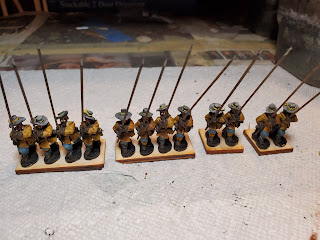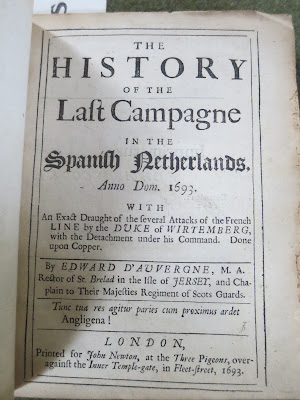Pikes in progress: part of the great rebasing project
(Apologies to the Bard, Henry VI, Part I [V. II. 18] for the title of this post)
Greetings fellow shut ins (well, here in the US, many of us are still in shut in mode). Like many others, one of my aims for this extended lockdown period has been to put a dent in the lead mountain, and also to give the toy-related detritus a good sort and clean out. I've already completed my first goal, painting up my Romanians, and I've now moved on to the clean out in the form of a major rebasing project that I've been putting off. Specifically, I've accumulated a goodly number of painted 28mm Thirty Years War figures via ebay and other sources over the last few years. Time to do what I've been avoiding: rebasing them. For those who really have time on their hands, you can check out my related post on basing figures. Moving on to the here and now, in this post, as usual, you may clix pix for BIG PIX.
For starters, I began with this unit of dragoons, which is double the fun because there is a dismounted figure for each mounted one. The cavalry bases are 1" x 2" and the infantry bases are 1" circulars. In the days when I first started this collection, I hand painted numbers on all of the pegs, and so for consistency still do so today. This has given me a great appreciation for the calligrapher's art (which I stink at). Nevertheless, I assauge myself by imagining that what my crude numerical renditions lack in style is made up for in their rustic charm (that's my story and I'm sticking with it!). I should add that this marking and basing scheme is intended to allow me to use these figures for a variety of systems. Let me digress for a moment to explain those prior to moving on....
This basing scheme will fit into my Smalle Warre 17th Century skirmish system, which employs units of 10 to 12 individually mounted figures, identified by color coded pegs on the back (and upon reviewing my page for this system, I see that I need to add a few lines of clarification to the rules). A game report on this system can be found on this blog for the curious. These same basing conventions and figure counts will allow me to also use this collection for a number of "company level" systems such as the Pikeman's Lament, Irregular Wars, Terra Incognita, and the Perfect Captain's ECW and Spanish Fury Actions systems. I can also use these figures at the man-to-man level, with each figure having individual statistics (wounds, etc, etc). I have run multiple games using a home grown rules system for this level, but have yet to publish it on this blog (the next project!).
Next up are the pikes: five units of 12 each (not counting command figures)
This configuration gives me the flexibility to show a 2-rank configuration without having an odd stand of four in the back (if all were on 4 figure bases), as well as facilitating the more standard 3-rank configuration. In addition, it allows for "making change" should a full stand of 4 loses 2 figures.
I also have command figures for each unit (should I need them). These are on 1" x 1" squares.
Given that the pikes won't be employed as individuals, I'll dispense with the numbers and pegs and instead just have a colored square on the back (eventually). In addition, each unit has a unifying "highlight" color (the Orange pike to the right and the Yellow to the left). In connection with adding the highlight color, any rebasing project I go into also tends to include some level of repainting in order add these kinds of touches and to make the figs consistent with the collection in general (yes: when I pay for painted figures, I almost always wind up repainting them--some more than others--too; makes no sense and makes perfect sense all at the same time). Next up will be applying the wood filler to each base (the most time consuming bit) and then the marking and flocking operation. When I'm done with this batch of 80+ figures, it will be on to the next ones in the queue...
...a unit of reiters and a unit of musketeers...
...another unit of musketeers...
...a unit of cuirassiers plus a contingent of Petardiers and Engineers...
...and a parcel of Scots (musketeers, pikes, cannoneers, and leaders).
Lets' see if I can complete this project before they come out with a COVID 19 vaccine!
Excelsior!




































